Poole Ch.P., Jr. Handbook of Superconductivity
Подождите немного. Документ загружается.

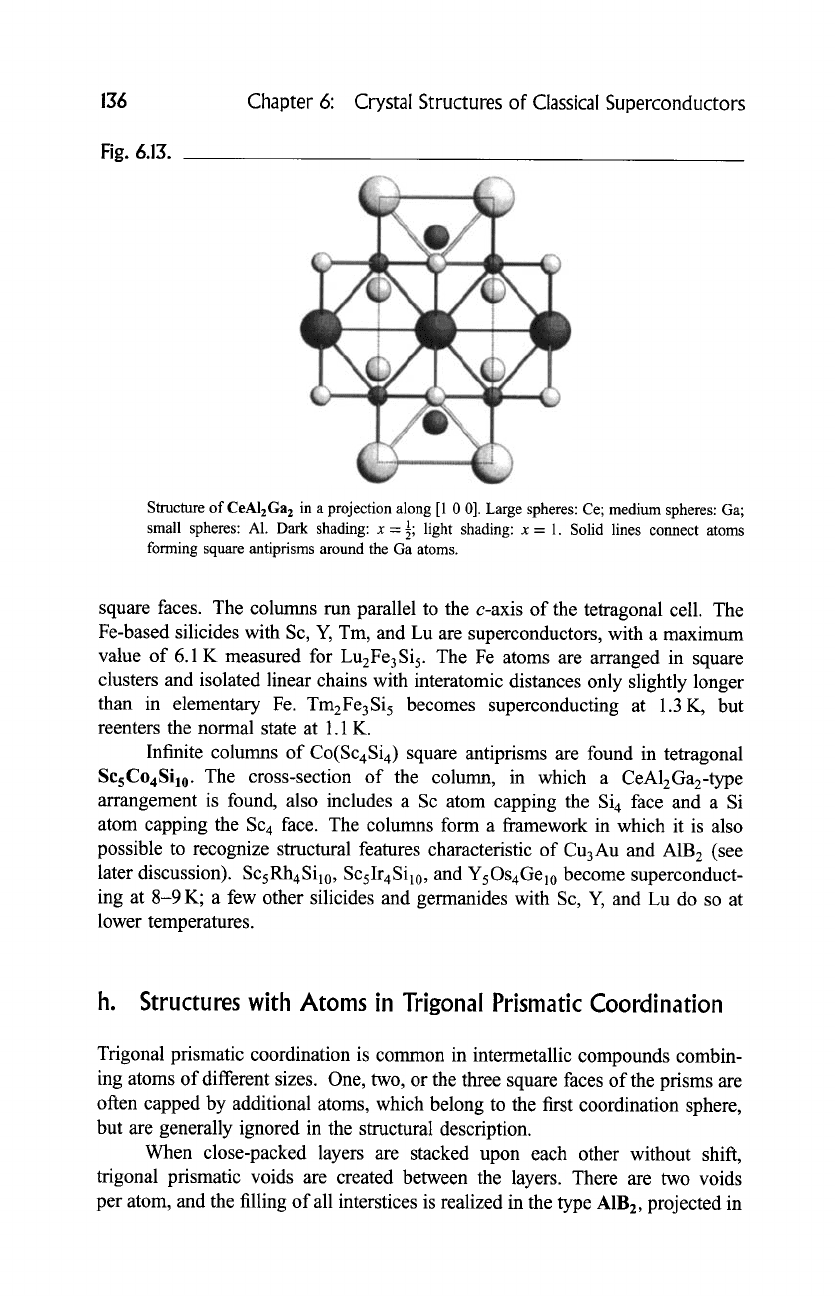
136
Fig. 6.13.
Chapter
6:
Crystal Structures of
Classical
Superconductors
Structure of CeAl2Ga 2 in a projection along [1 0 0]. Large spheres: Ce; medium spheres: Ga;
small spheres: A1. Dark shading: x = 89 light shading: x = 1. Solid lines connect atoms
forming square antiprisms around the Ga atoms.
square faces. The columns run parallel to the c-axis of the tetragonal cell. The
Fe-based silicides with Sc, Y, Tm, and Lu are superconductors, with a maximum
value of 6.1 K measured for Lu2Fe3Si 5. The Fe atoms are arranged in square
clusters and isolated linear chains with interatomic distances only slightly longer
than in elementary Fe. Tm2Fe3Si 5 becomes superconducting at 1.3K, but
reenters the normal state at 1.1 K.
Infinite columns of
Co(Sc4Si4)
square antiprisms are found in tetragonal
Se5Co4Silo. The cross-section of the column, in which a CeA12GaE-type
arrangement is found, also includes a Sc atom capping the Si 4 face and a Si
atom capping the Sc 4 face. The columns form a framework in which it is also
possible to recognize structural features characteristic of CuaAu and A1B 2 (see
later discussion). Sc5Rh4Silo , Sc5Ir4Silo , and Y5Os4Gelo become superconduct-
ing at 8-9 K; a few other silicides and germanides with Sc, Y, and Lu do so at
lower temperatures.
h. Structures with Atoms in Trigonal Prismatic Coordination
Trigonal prismatic coordination is common in intermetallic compounds combin-
ing atoms of different sizes. One, two, or the three square faces of the prisms are
often capped by additional atoms, which belong to the first coordination sphere,
but are generally ignored in the structural description.
When close-packed layers are stacked upon each other without shift,
trigonal prismatic voids are created between the layers. There are two voids
per atom, and the filling of all interstices is realized in the type AIB2, projected in
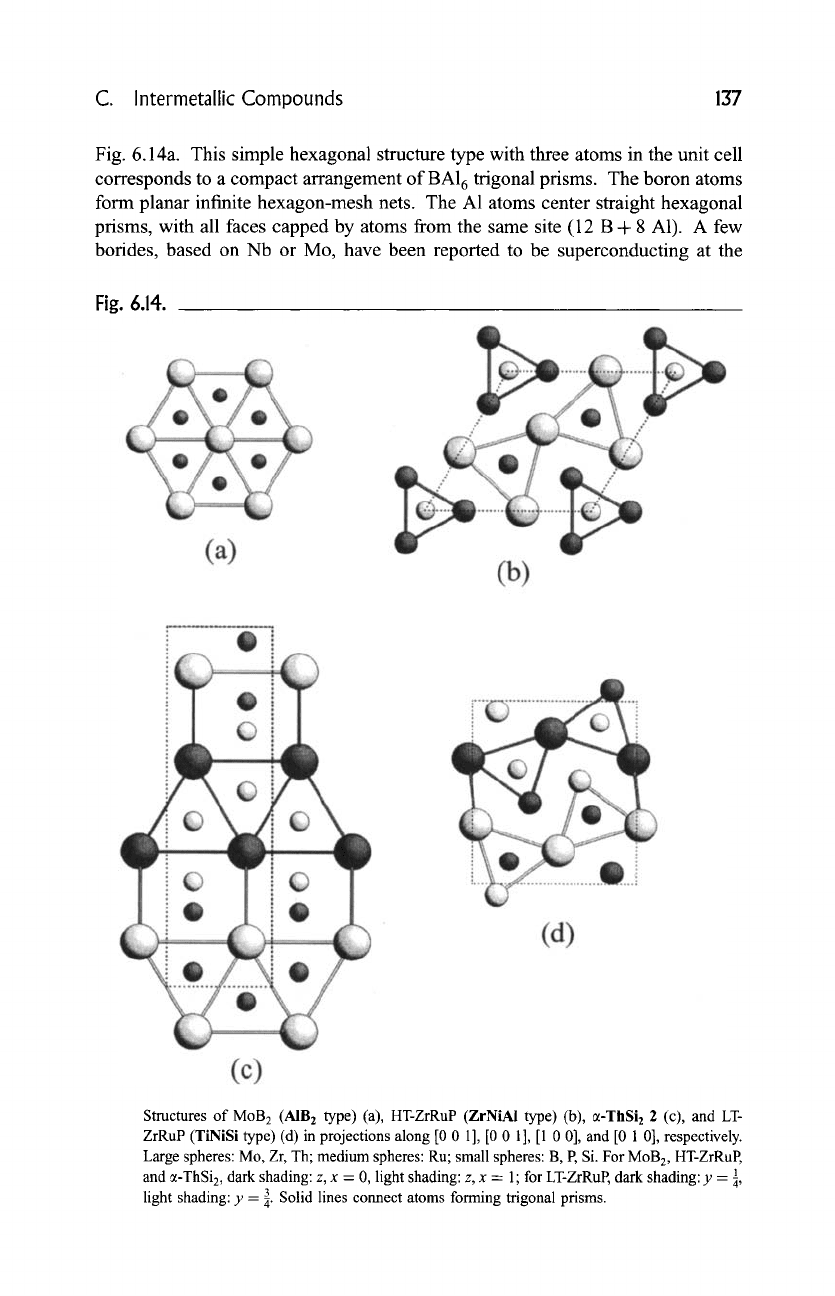
C. Intermetallic Compounds IT/
Fig. 6.14a. This simple hexagonal structure type with three atoms in the unit cell
corresponds to a compact arrangement ofBA16 trigonal prisms. The boron atoms
form planar infinite hexagon-mesh nets. The A1 atoms center straight hexagonal
prisms, with all faces capped by atoms from the same site (12 B + 8 A1). A few
borides, based on Nb or Mo, have been reported to be superconducting at the
Fig. 6.14.
Structures of MoB 2 (AIB 2 type) (a), HT-ZrRuP (ZrNiAl type) (b), ~-ThSi 2 2 (c), and LT-
ZrRuP (TiNiSi type) (d) in projections along [0 0 1], [0 0 1], [1 0 0], and [0 1 0], respectively.
Large spheres: Mo, Zr, Th; medium spheres: Ru; small spheres: B, P, Si. For MOB2, HT-ZrRuP,
1
and ~-ThSi2, dark shading: z, x = 0, light shading: z, x -- 1; for LT-ZrRuP, dark shading: y = ~,
light shading: y = 3. Solid lines connect atoms forming trigonal prisms.
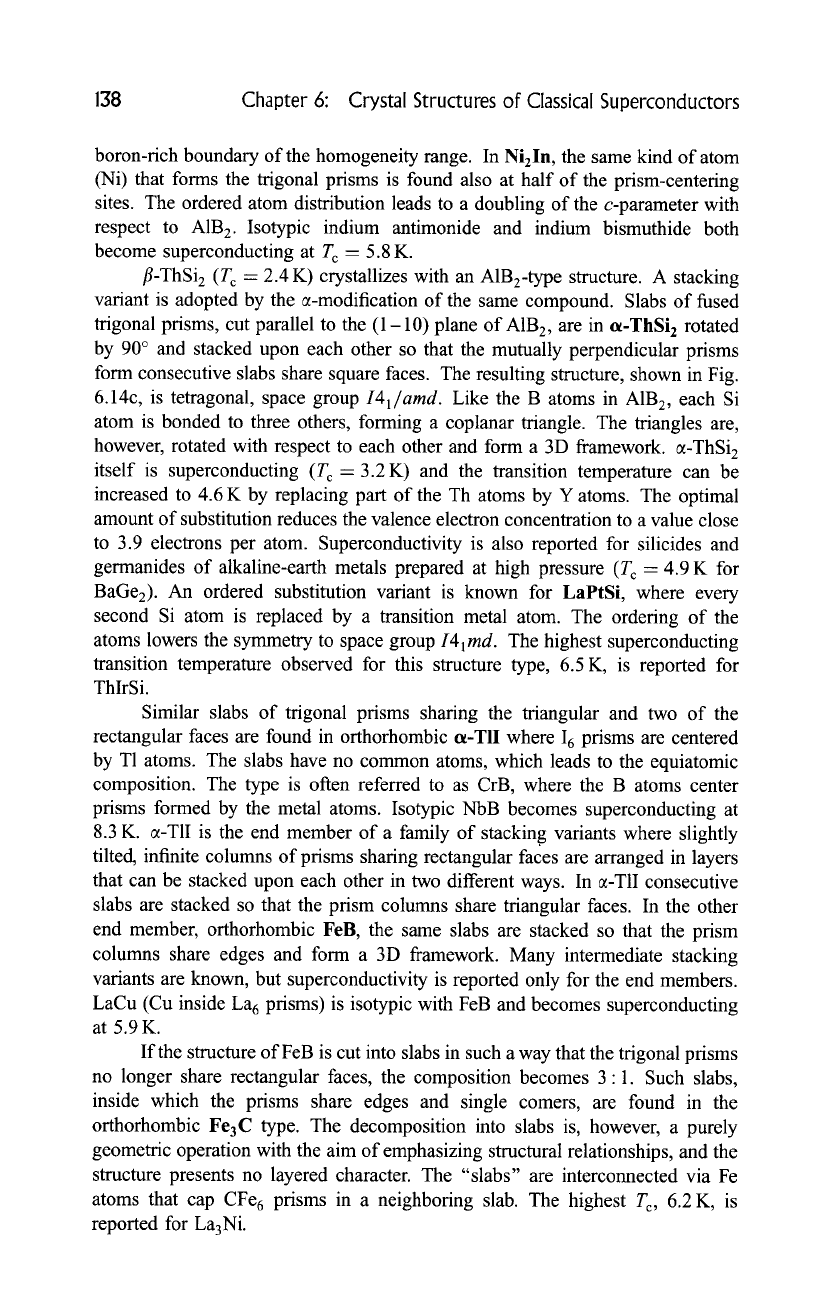
138
Chapter 6: Crystal Structures of Classical Superconductors
boron-rich boundary of the homogeneity range. In Ni2In, the same kind of atom
(Ni) that forms the trigonal prisms is found also at half of the prism-centering
sites. The ordered atom distribution leads to a doubling of the c-parameter with
respect to A1B 2. Isotypic indium antimonide and indium bismuthide both
become superconducting at T c = 5.8 K.
fl-ThSi 2 (T c - 2.4 K) crystallizes with an A1B2-type structure. A stacking
variant is adopted by the a-modification of the same compound. Slabs of fused
trigonal prisms, cut parallel to the (1-10) plane of A1B2, are in et-ThSi 2 rotated
by 90 ~ and stacked upon each other so that the mutually perpendicular prisms
form consecutive slabs share square faces. The resulting structure, shown in Fig.
6.14c, is tetragonal, space group
I41/amd.
Like the B atoms in A1B2, each Si
atom is bonded to three others, forming a coplanar triangle. The triangles are,
however, rotated with respect to each other and form a 3D framework. ~-ThSi 2
itself is superconducting (To = 3.2 K) and the transition temperature can be
increased to 4.6 K by replacing part of the Th atoms by Y atoms. The optimal
amount of substitution reduces the valence electron concentration to a value close
to 3.9 electrons per atom. Superconductivity is also reported for silicides and
germanides of alkaline-earth metals prepared at high pressure (T~ --4.9 K for
BaGe2). An ordered substitution variant is known for LaPtSi, where every
second Si atom is replaced by a transition metal atom. The ordering of the
atoms lowers the symmetry to space group
I41md.
The highest superconducting
transition temperature observed for this structure type, 6.5 K, is reported for
ThIrSi.
Similar slabs of trigonal prisms sharing the triangular and two of the
rectangular faces are found in orthorhombic ot-TlI where 16 prisms are centered
by T1 atoms. The slabs have no common atoms, which leads to the equiatomic
composition. The type is often referred to as CrB, where the B atoms center
prisms formed by the metal atoms. Isotypic NbB becomes superconducting at
8.3 K. ~-TII is the end member of a family of stacking variants where slightly
tilted, infinite columns of prisms sharing rectangular faces are arranged in layers
that can be stacked upon each other in two different ways. In ~-TII consecutive
slabs are stacked so that the prism columns share triangular faces. In the other
end member, orthorhombic FeB, the same slabs are stacked so that the prism
columns share edges and form a 3D framework. Many intermediate stacking
variants are known, but superconductivity is reported only for the end members.
LaCu (Cu inside La6 prisms) is isotypic with FeB and becomes superconducting
at 5.9K.
If the structure of FeB is cut into slabs in such a way that the trigonal prisms
no longer share rectangular faces, the composition becomes 3:1. Such slabs,
inside which the prisms share edges and single comers, are found in the
orthorhombic Fe3C type. The decomposition into slabs is, however, a purely
geometric operation with the aim of emphasizing structural relationships, and the
structure presents no layered character. The "slabs" are interconnected via Fe
atoms that cap CFe 6 prisms in a neighboring slab. The highest T~, 6.2 K, is
reported for La3Ni.
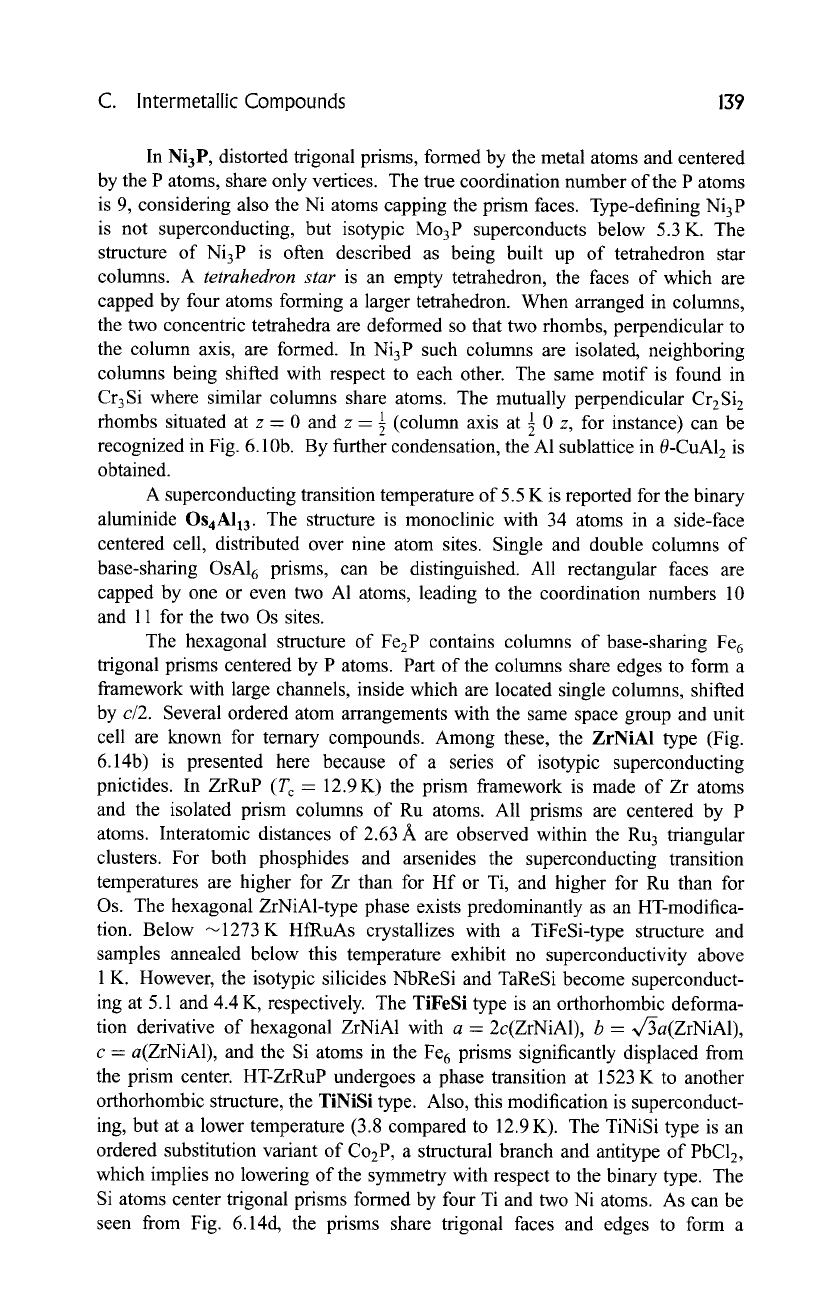
C. lntermetallic Compounds 139
In Ni3P, distorted trigonal prisms, formed by the metal atoms and centered
by the P atoms, share only vertices. The true coordination number of the P atoms
is 9, considering also the Ni atoms capping the prism faces. Type-defining Ni3P
is not superconducting, but isotypic Mo3P superconducts below 5.3 K. The
structure of Ni3P is often described as being built up of tetrahedron star
columns. A
tetrahedron star
is an empty tetrahedron, the faces of which are
capped by four atoms forming a larger tetrahedron. When arranged in columns,
the two concentric tetrahedra are deformed so that two rhombs, perpendicular to
the column axis, are formed. In Ni3P such columns are isolated, neighboring
columns being shifted with respect to each other. The same motif is found in
Cr3Si where similar columns share atoms. The mutually perpendicular Cr2Si 2
rhombs situated at z - 0 and z - 1 (column axis at 89 0 z, for instance) can be
recognized in Fig. 6.10b. By further condensation, the A1 sublattice in 0-CuA12 is
obtained.
A superconducting transition temperature of 5.5 K is reported for the binary
aluminide Os4A113. The structure is monoclinic with 34 atoms in a side-face
centered cell, distributed over nine atom sites. Single and double columns of
base-sharing OsA16 prisms, can be distinguished. All rectangular faces are
capped by one or even two A1 atoms, leading to the coordination numbers 10
and 11 for the two Os sites.
The hexagonal structure of Fe2P contains columns of base-sharing Fe 6
trigonal prisms centered by P atoms. Part of the columns share edges to form a
framework with large channels, inside which are located single columns, shifted
by
c/2.
Several ordered atom arrangements with the same space group and unit
cell are known for ternary compounds. Among these, the ZrNiAl type (Fig.
6.14b) is presented here because of a series of isotypic superconducting
pnictides. In ZrRuP (T c = 12.9 K) the prism framework is made of Zr atoms
and the isolated prism columns of Ru atoms. All prisms are centered by P
atoms. Interatomic distances of 2.63 A are observed within the Ru 3 triangular
clusters. For both phosphides and arsenides the superconducting transition
temperatures are higher for Zr than for Hf or Ti, and higher for Ru than for
Os. The hexagonal ZrNiAl-type phase exists predominantly as an HT-modifica-
tion. Below ,~1273 K HfRuAs crystallizes with a TiFeSi-type structure and
samples annealed below this temperature exhibit no superconductivity above
1 K. However, the isotypic silicides NbReSi and TaReSi become superconduct-
ing at 5.1 and 4.4 K, respectively. The TiFeSi type is an orthorhombic deforma-
tion derivative of hexagonal ZrNiA1 with a = 2c(ZrNiA1), b = V~a(ZrNiA1),
c = a(ZrNiA1), and the Si atoms in the Fe 6 prisms significantly displaced from
the prism center. HT-ZrRuP undergoes a phase transition at 1523 K to another
orthorhombic structure, the TiNiSi type. Also, this modification is superconduct-
ing, but at a lower temperature (3.8 compared to 12.9 K). The TiNiSi type is an
ordered substitution variant of CozP , a structural branch and antitype of PbC12,
which implies no lowering of the symmetry with respect to the binary type. The
Si atoms center trigonal prisms formed by four Ti and two Ni atoms. As can be
seen from Fig. 6.14d, the prisms share trigonal faces and edges to form a
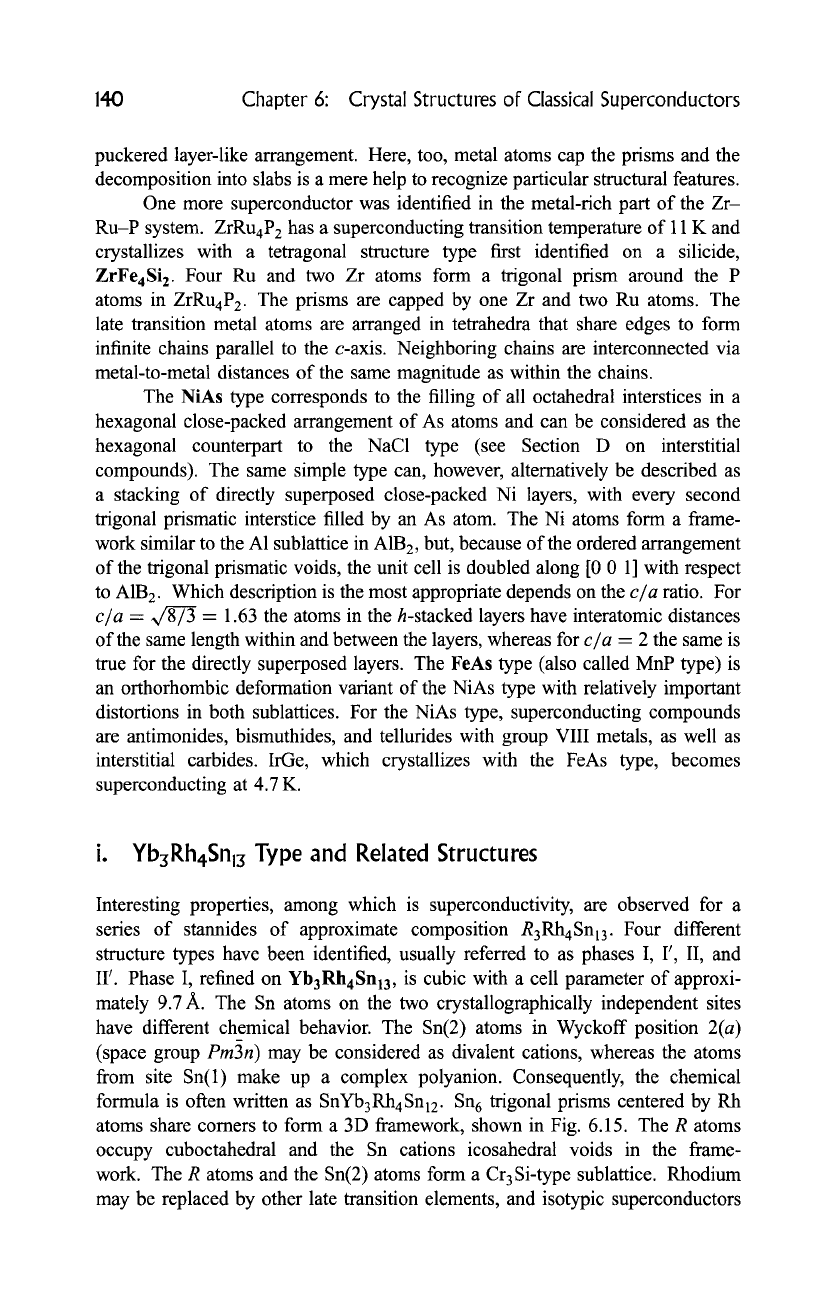
140 Chapter 6: Crystal Structures of Classical Superconductors
puckered layer-like arrangement. Here, too, metal atoms cap the prisms and the
decomposition into slabs is a mere help to recognize particular structural features.
One more superconductor was identified in the metal-rich part of the Zr-
Ru-P system. ZrRu4P2 has a superconducting transition temperature of 11 K and
crystallizes with a tetragonal structure type first identified on a silicide,
ZrFe4Si2. Four Ru and two Zr atoms form a trigonal prism around the P
atoms in ZrRuaP 2. The prisms are capped by one Zr and two Ru atoms. The
late transition metal atoms are arranged in tetrahedra that share edges to form
infinite chains parallel to the c-axis. Neighboring chains are interconnected via
metal-to-metal distances of the same magnitude as within the chains.
The NiAs type corresponds to the filling of all octahedral interstices in a
hexagonal close-packed arrangement of As atoms and can be considered as the
hexagonal counterpart to the NaC1 type (see Section D on interstitial
compounds). The same simple type can, however, alternatively be described as
a stacking of directly superposed close-packed Ni layers, with every second
trigonal prismatic interstice filled by an As atom. The Ni atoms form a frame-
work similar to the A1 sublattice in A1B 2, but, because of the ordered arrangement
of the trigonal prismatic voids, the unit cell is doubled along [0 0 1] with respect
to A1B2. Which description is the most appropriate depends on the
c/a
ratio. For
c/a
-- v/-g-/3 = 1.63 the atoms in the h-stacked layers have interatomic distances
of the same length within and between the layers, whereas for
c/a
= 2 the same is
true for the directly superposed layers. The FeAs type (also called MnP type) is
an orthorhombic deformation variant of the NiAs type with relatively important
distortions in both sublattices. For the NiAs type, superconducting compounds
are antimonides, bismuthides, and tellurides with group VIII metals, as well as
interstitial carbides. IrGe, which crystallizes with the FeAs type, becomes
superconducting at 4.7 K.
i. YbzRh4Sn~3 Type and Related Structures
Interesting properties, among which is superconductivity, are observed for a
series of stannides of approximate composition R3Rh4Snl3. Four different
structure types have been identified, usually referred to as phases I, I', II, and
II'. Phase I, refined on Yb3Rh4Snl3 , is cubic with a cell parameter of approxi-
mately 9.7 A. The Sn atoms on the two crystallographically independent sites
have different chemical behavior. The Sn(2) atoms in Wyckoff position 2(a)
(space group
Pm3n)
may be considered as divalent cations, whereas the atoms
from site Sn(1) make up a complex polyanion. Consequently, the chemical
formula is often written as SnYb3RhaSnl2. Sn 6 trigonal prisms centered by Rh
atoms share comers to form a 3D framework, shown in Fig. 6.15. The R atoms
occupy cuboctahedral and the Sn cations icosahedral voids in the flame-
work. The R atoms and the Sn(2) atoms form a Cr3Si-type sublattice. Rhodium
may be replaced by other late transition elements, and isotypic superconductors
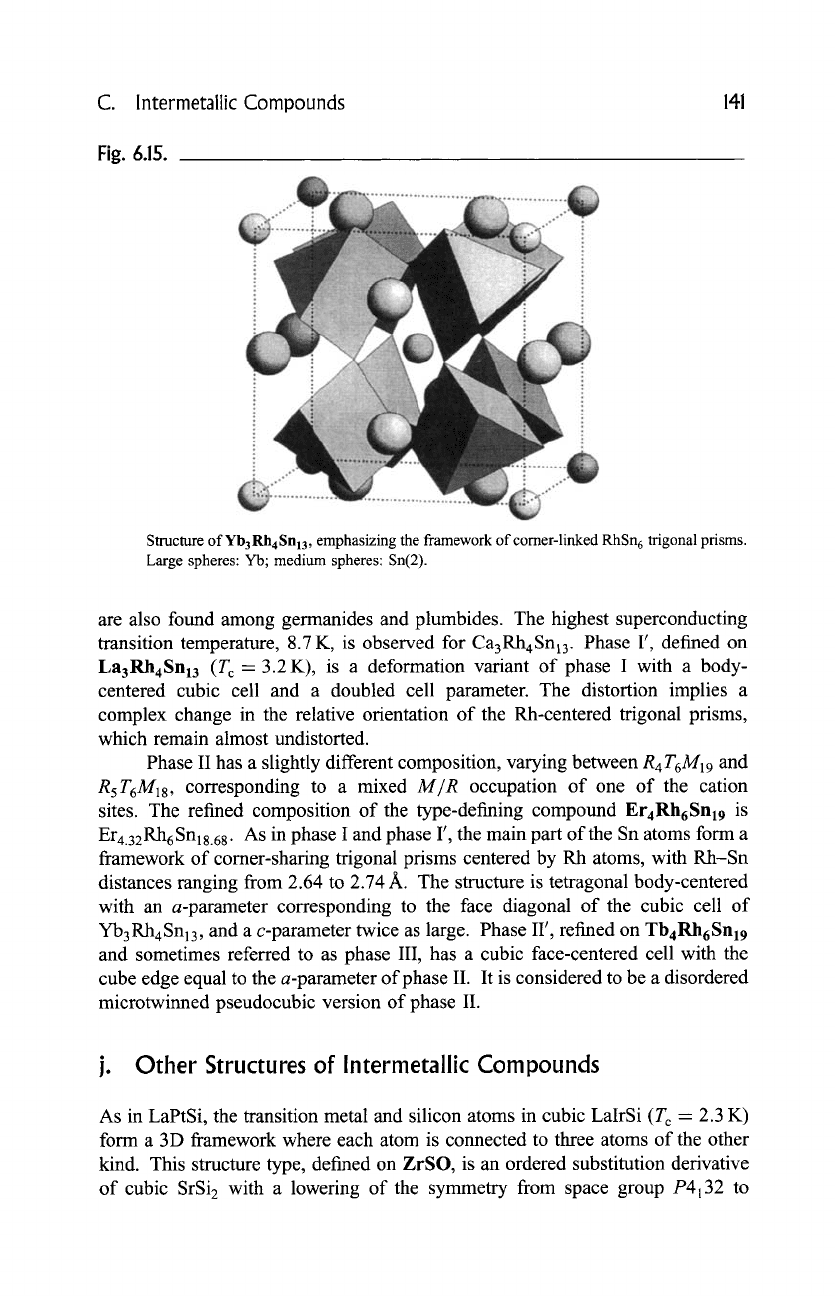
C. Interrnetailic Compounds 141
Fig. 6.15.
Structure
ofYb3Rh4Snl3 ,
emphasizing the framework of corner-linked
RhSn 6
trigonal prisms.
Large spheres: Yb; medium spheres: Sn(2).
are also found among germanides and plumbides. The highest superconducting
transition temperature, 8.7K, is observed for Ca3Rh4Sn13. Phase I', defined on
La3Rh4Sn13 (T c = 3.2K), is a deformation variant of phase I with a body-
centered cubic cell and a doubled cell parameter. The distortion implies a
complex change in the relative orientation of the Rh-centered trigonal prisms,
which remain almost undistorted.
Phase II has a slightly different composition, varying between R 4
T6M19
and
RsT6M18,
corresponding to a mixed
M/R
occupation of one of the cation
sites. The refined composition of the type-defining compound Er4Rh6Sn19 is
Erg.32Rh6Sn18.68.
As in phase I and phase I', the main part of the Sn atoms form a
framework of corner-sharing trigonal prisms centered by Rh atoms, with Rh-Sn
distances ranging from 2.64 to 2.74 A. The structure is tetragonal body-centered
with an a-parameter corresponding to the face diagonal of the cubic cell of
Yb3RhgSnl3 ,
and a c-parameter twice as large. Phase II', refined
on Tb4Rh6Sn19
and sometimes referred to as phase III, has a cubic face-centered cell with the
cube edge equal to the a-parameter of phase II. It is considered to be a disordered
microtwinned pseudocubic version of phase II.
j. Other Structures of Intermetallic Compounds
As in LaPtSi, the transition metal and silicon atoms in cubic LaIrSi (T c = 2.3 K)
form a 3D framework where each atom is connected to three atoms of the other
kind. This structure type, defined on ZrSO, is an ordered substitution derivative
of cubic SrSi 2 with a lowering of the symmetry from space group P4132 to
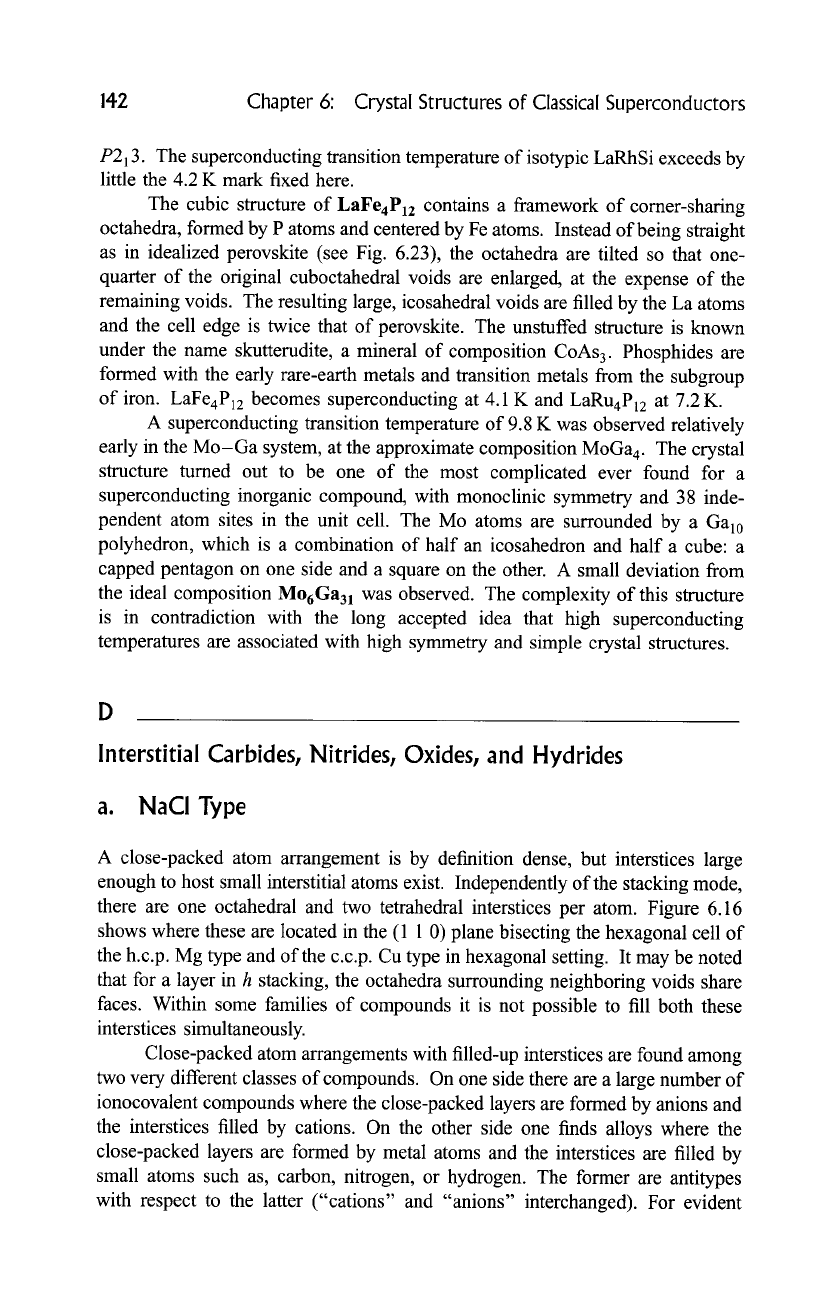
142
Chapter 6: Crystal Structures of Classical Superconductors
P213. The superconducting transition temperature of isotypic LaRhSi exceeds by
little the 4.2 K mark fixed here.
The cubic structure of LaFe4P12 contains a framework of corner-sharing
octahedra, formed by P atoms and centered by Fe atoms. Instead of being straight
as in idealized perovskite (see Fig. 6.23), the octahedra are tilted so that one-
quarter of the original cuboctahedral voids are enlarged, at the expense of the
remaining voids. The resulting large, icosahedral voids are filled by the La atoms
and the cell edge is twice that of perovskite. The unstuffed structure is known
under the name skutterudite, a mineral of composition CoAs 3. Phosphides are
formed with the early rare-earth metals and transition metals from the subgroup
of iron. LaFe4P12 becomes superconducting at 4.1 K and LaRu4P12 at 7.2 K.
A superconducting transition temperature of 9.8 K was observed relatively
early in the Mo-Ga system, at the approximate composition MoGa 4. The crystal
structure turned out to be one of the most complicated ever found for a
superconducting inorganic compound, with monoclinic symmetry and 38 inde-
pendent atom sites in the unit cell. The Mo atoms are surrounded by a Gal0
polyhedron, which is a combination of half an icosahedron and half a cube: a
capped pentagon on one side and a square on the other. A small deviation from
the ideal composition Mo6Ga31 was observed. The complexity of this structure
is in contradiction with the long accepted idea that high superconducting
temperatures are associated with high symmetry and simple crystal structures.
D
Interstitial Carbides, Nitrides, Oxides, and Hydrides
a. NaCI Type
A close-packed atom arrangement is by definition dense, but interstices large
enough to host small interstitial atoms exist. Independently of the stacking mode,
there are one octahedral and two tetrahedral interstices per atom. Figure
6.16
shows where these are located in the (1 1 O) plane bisecting the hexagonal cell of
the h.c.p. Mg type and of the c.c.p. Cu type in hexagonal setting. It may be noted
that for a layer in h stacking, the octahedra surrounding neighboring voids share
faces. Within some families of compounds it is not possible to fill both these
interstices simultaneously.
Close-packed atom arrangements with filled-up interstices are found among
two very different classes of compounds. On one side there are a large number of
ionocovalent compounds where the close-packed layers are formed by anions and
the interstices filled by cations. On the other side one finds alloys where the
close-packed layers are formed by metal atoms and the interstices are filled by
small atoms such as, carbon, nitrogen, or hydrogen. The former are antitypes
with respect to the latter ("cations" and "anions" interchanged). For evident
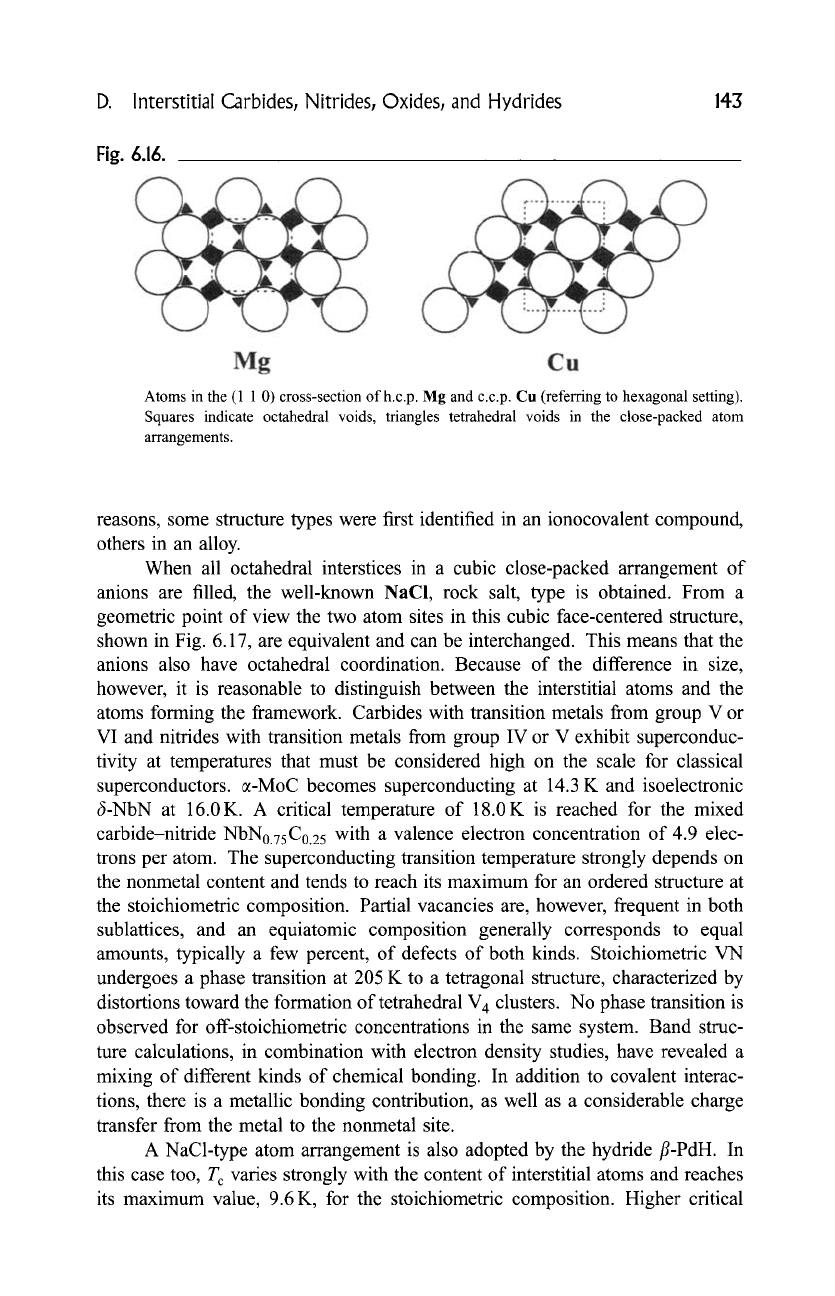
D. Interstitial Carbides, Nitrides, Oxides, and Hydrides 143
Fig. 6.16.
Atoms in the (1 1 O) cross-section of h.c.p. Mg and c.c.p. Cu (referring to hexagonal setting).
Squares indicate octahedral voids, triangles tetrahedral voids in the close-packed atom
arrangements.
reasons, some structure types were first identified in an ionocovalent compound,
others in an alloy.
When all octahedral interstices in a cubic close-packed arrangement of
anions are filled, the well-known NaCl, rock salt, type is obtained. From a
geometric point of view the two atom sites in this cubic face-centered structure,
shown in Fig. 6.17, are equivalent and can be interchanged. This means that the
anions also have octahedral coordination. Because of the difference in size,
however, it is reasonable to distinguish between the interstitial atoms and the
atoms forming the framework. Carbides with transition metals from group V or
VI and nitrides with transition metals from group IV or V exhibit superconduc-
tivity at temperatures that must be considered high on the scale for classical
superconductors. ~-MoC becomes superconducting at 14.3 K and isoelectronic
6-NbN at 16.0 K. A critical temperature of 18.0 K is reached for the mixed
carbide-nitride NbN0.75C0.25 with a valence electron concentration of 4.9 elec-
trons per atom. The superconducting transition temperature strongly depends on
the nonmetal content and tends to reach its maximum for an ordered structure at
the stoichiometric composition. Partial vacancies are, however, frequent in both
sublattices, and an equiatomic composition generally corresponds to equal
amounts, typically a few percent, of defects of both kinds. Stoichiometric VN
undergoes a phase transition at 205 K to a tetragonal structure, characterized by
distortions toward the formation of tetrahedral V 4 clusters. No phase transition is
observed for off-stoichiometric concentrations in the same system. Band struc-
ture calculations, in combination with electron density studies, have revealed a
mixing of different kinds of chemical bonding. In addition to covalent interac-
tions, there is a metallic bonding contribution, as well as a considerable charge
transfer from the metal to the nonmetal site.
A NaCl-type atom arrangement is also adopted by the hydride fl-PdH. In
this case too, T c varies strongly with the content of interstitial atoms and reaches
its maximum value, 9.6 K, for the stoichiometric composition. Higher critical
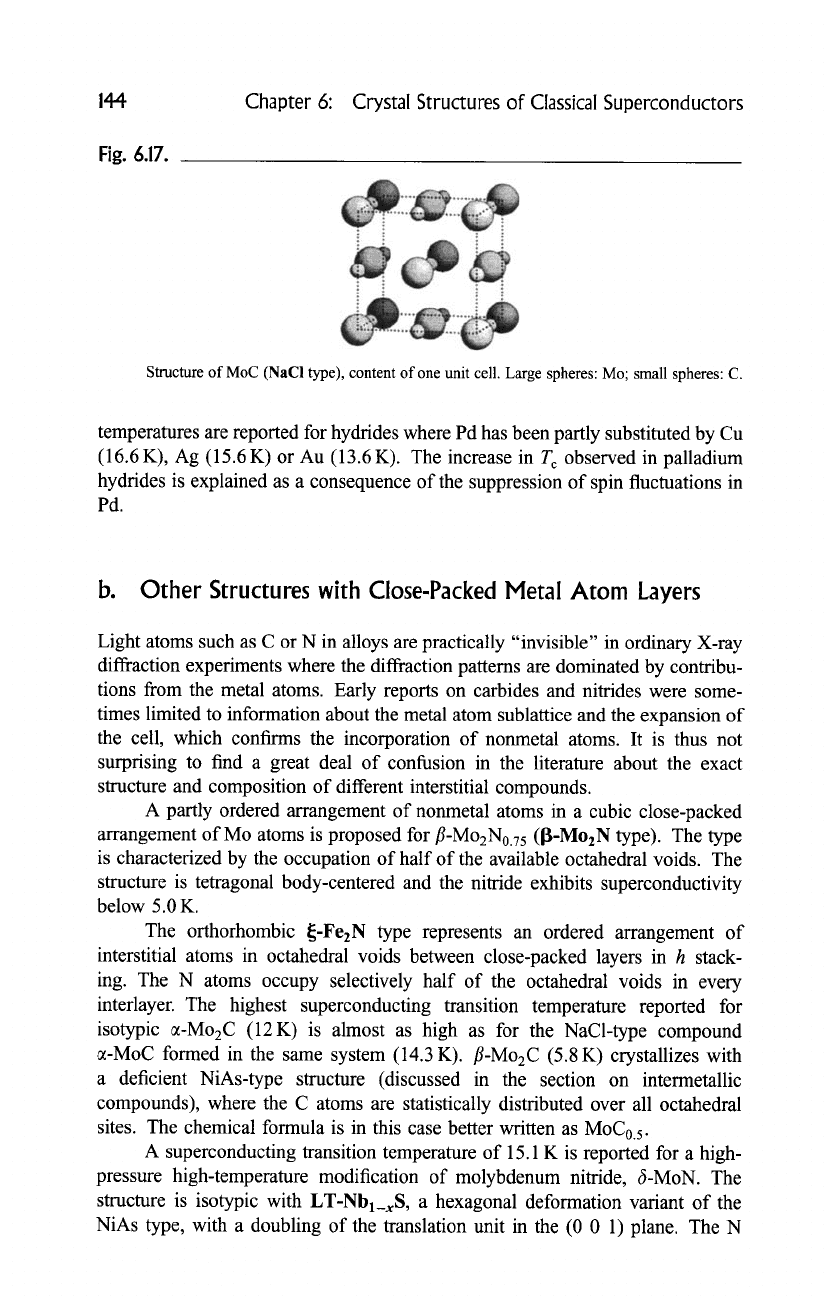
144 Chapter 6:
Fig. 6.17.
Crystal Structures of Classical Superconductors
Structure of MoC (NaCI type), content of one unit cell. Large spheres: Mo; small spheres: C.
temperatures are reported for hydrides where Pd has been partly substituted by Cu
(16.6 K), Ag (15.6 K) or Au (13.6 K). The increase in T c observed in palladium
hydrides is explained as a consequence of the suppression of spin fluctuations in
Pd.
b. Other Structures with Close-Packed Metal Atom Layers
Light atoms such as C or N in alloys are practically "invisible" in ordinary X-ray
diffraction experiments where the diffraction patterns are dominated by contribu-
tions from the metal atoms. Early reports on carbides and nitrides were some-
times limited to information about the metal atom sublattice and the expansion of
the cell, which confirms the incorporation of nonmetal atoms. It is thus not
surprising to find a great deal of confusion in the literature about the exact
structure and composition of different interstitial compounds.
A partly ordered arrangement of nonmetal atoms in a cubic close-packed
arrangement of Mo atoms is proposed for fl-Mo2N0.75 ([~-Mo2N type). The type
is characterized by the occupation of half of the available octahedral voids. The
structure is tetragonal body-centered and the nitride exhibits superconductivity
below 5.0 K.
The orthorhombic ~j-Fe2N type represents an ordered arrangement of
interstitial atoms in octahedral voids between close-packed layers in h stack-
ing. The N atoms occupy selectively half of the octahedral voids in every
interlayer. The highest superconducting transition temperature reported for
isotypic ~-Mo2C (12 K) is almost as high as for the NaCl-type compound
~-MoC formed in the same system (14.3 K). fl-Mo2C (5.8 K) crystallizes with
a deficient NiAs-type structure (discussed in the section on intermetallic
compounds), where the C atoms are statistically distributed over all octahedral
sites. The chemical formula is in this case better written as MoC0. 5.
A superconducting transition temperature of 15.1 K is reported for a high-
pressure high-temperature modification of molybdenum nitride, 6-MoN. The
structure is isotypic with LT-Nbl_xS , a hexagonal deformation variant of the
NiAs type, with a doubling of the translation unit in the (0 0 1) plane. The N
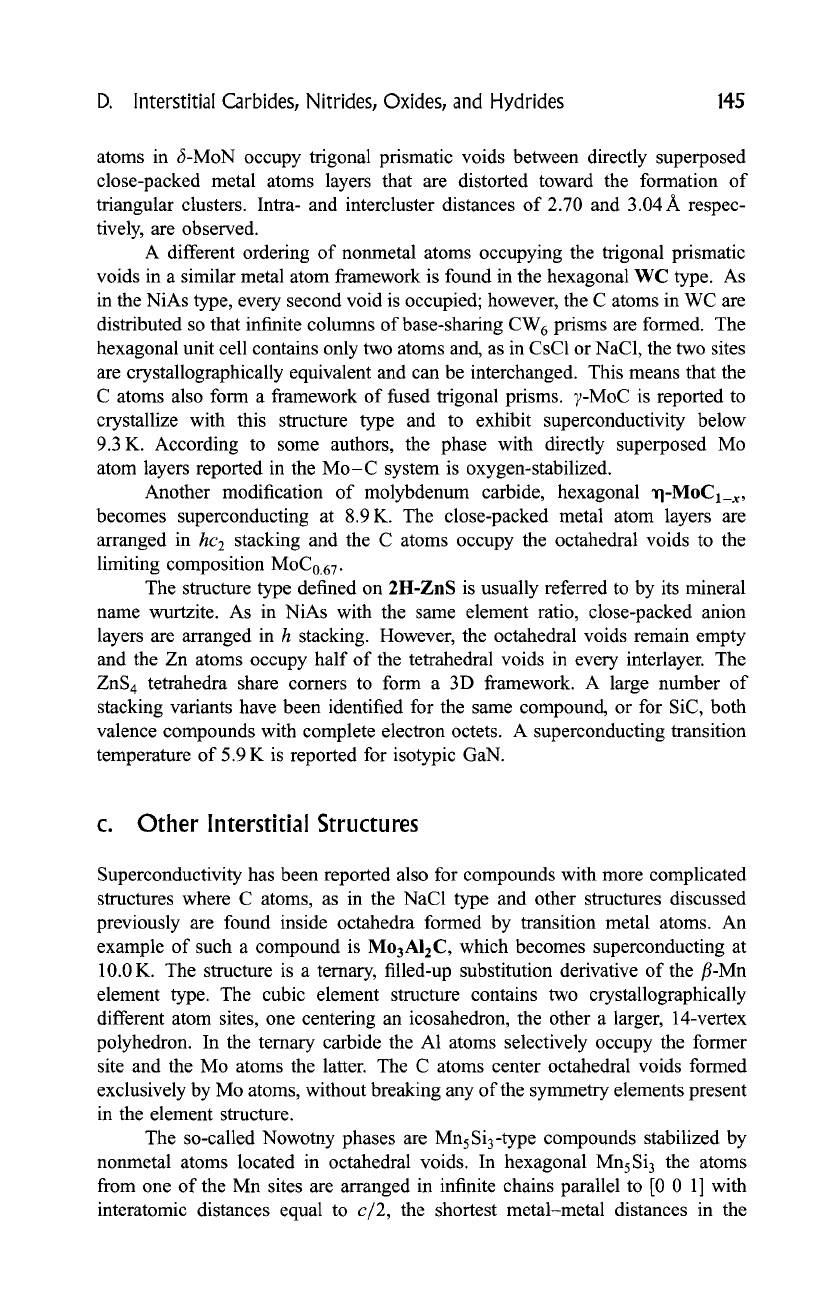
D. Interstitial Carbides, Nitrides, Oxides, and Hydrides 145
atoms in 6-MoN occupy trigonal prismatic voids between directly superposed
close-packed metal atoms layers that are distorted toward the formation of
triangular clusters. Intra- and intercluster distances of 2.70 and 3.04 A respec-
tively, are observed.
A different ordering of nonmetal atoms occupying the trigonal prismatic
voids in a similar metal atom framework is found in the hexagonal WC type. As
in the NiAs type, every second void is occupied; however, the C atoms in WC are
distributed so that infinite columns of base-sharing CW6 prisms are formed. The
hexagonal unit cell contains only two atoms and, as in CsC1 or NaC1, the two sites
are crystallographically equivalent and can be interchanged. This means that the
C atoms also form a framework of fused trigonal prisms. 7-MoC is reported to
crystallize with this structure type and to exhibit superconductivity below
9.3 K. According to some authors, the phase with directly superposed Mo
atom layers reported in the Mo-C system is oxygen-stabilized.
Another modification of molybdenum carbide, hexagonal ~l-MOCl_x,
becomes superconducting at 8.9 K. The close-packed metal atom layers are
arranged in
hc 2
stacking and the C atoms occupy the octahedral voids to the
limiting composition
MOC0.67.
The structure type defined on 2H-ZnS is usually referred to by its mineral
name wurtzite. As in NiAs with the same element ratio, close-packed anion
layers are arranged in h stacking. However, the octahedral voids remain empty
and the Zn atoms occupy half of the tetrahedral voids in every interlayer. The
ZnS 4 tetrahedra share corners to form a 3D framework. A large number of
stacking variants have been identified for the same compound, or for SiC, both
valence compounds with complete electron octets. A superconducting transition
temperature of 5.9 K is reported for isotypic GaN.
c. Other Interstitial Structures
Superconductivity has been reported also for compounds with more complicated
structures where C atoms, as in the NaC1 type and other structures discussed
previously are found inside octahedra formed by transition metal atoms. An
example of such a compound is Mo3AI2C, which becomes superconducting at
10.0 K. The structure is a temary, filled-up substitution derivative of the//-Mn
element type. The cubic element structure contains two crystallographically
different atom sites, one centering an icosahedron, the other a larger, 14-vertex
polyhedron. In the ternary carbide the A1 atoms selectively occupy the former
site and the Mo atoms the latter. The C atoms center octahedral voids formed
exclusively by Mo atoms, without breaking any of the symmetry elements present
in the element structure.
The so-called Nowotny phases are MnsSi3-type compounds stabilized by
nonmetal atoms located in octahedral voids. In hexagonal MnsSi 3 the atoms
from one of the Mn sites are arranged in infinite chains parallel to [0 0 1] with
interatomic distances equal to
c/2,
the shortest metal-metal distances in the
